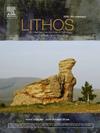蛇绿岩和深海橄榄岩热史研究的意义
IF 2.5
2区 地球科学
Q2 GEOCHEMISTRY & GEOPHYSICS
引用次数: 0
摘要
为了了解其热历史的地质意义,我们评估了深海和蛇绿岩地质背景下的橄榄岩记录的温度和冷却速率,并通过对Masirah(一种洋中脊型蛇绿岩,具有薄但完整的火成岩地壳)橄榄岩的新分析提供了数据。从岩浆或岩浆匮乏的扩张中心、核复合体、转换断层和东太平洋隆起(赫斯深)下形成的暴露地幔岩石圈的构造窗口的海底疏浚或钻探的橄榄岩构成了我们所说的深海橄榄岩。我们还考虑了从弧前环境中回收的少量橄榄岩。我们通过对高温冷却敏感的稀土元素(REE)温度计和对低温亚固体冷却敏感的主要元素温度计来评估温度。将恢复的冷却速率与简单热传导模型的结果进行比较,该模型可用于背景化样品确定的热历史。传导冷却到冷热边界的物体内的冷却速率随温度和到边界的距离(即传导冷却长度)的函数而变化。对马西拉橄榄岩冷却速率的分析表明,马西拉下地壳和上地幔为传导冷却,上覆挤压地壳为水热冷却。这一结果与另一个地壳截面较薄的古扩张中心对冷却速率空间变化的解释一致,但与厚地壳截面的古扩张中心的观测结果对比,表明岩石圈对壳幔边界的热液冷却和下地幔的导电冷却。在全球数据集中,蛇绿橄榄岩记录的温度在较低的温度区间低于深海橄榄岩。温度计测得的温度对样品热历史的意义取决于晶粒的大小。我们评估了我们自己的样品和文献汇编中报告的颗粒尺寸,发现蛇绿岩和深海环境之间没有统计学上显著的偏差,因此蛇绿岩橄榄岩记录的较低温度表明蛇绿岩比深海橄榄岩冷却得慢。在导电冷却模式的背景下,这种差异可以解释为反映了不同设置之间导电冷却长度尺度的差异,蛇绿岩在数百米至10公里的长度尺度上冷却,而深海橄榄岩在更短的长度尺度上冷却,这是由它们通过地热的平流压缩而成的。在某些情况下,许多蛇绿岩上的地壳剖面可能限制了热液循环的深度,产生比岩浆缺乏的深海环境更厚的导电冷却区,并且/或者在蛇绿岩上对更深的地幔岩石圈部分取样的便便性使蛇绿岩样品记录偏向于更长的导电长度尺度。对深海橄榄岩温度分布的评价表明,冷却速率与扩散速率呈正相关。根据全球温度数据计算的冷却速率与通过传导性地热的简单平流上升岩石圈模型在质量上一致,但被低估了,这意味着在岩浆匮乏的深海环境中,浅层热液循环在一定程度上冷却了地幔,热传导和通过地热的平流速率都在确定深海环境中橄榄岩的热历史中发挥了作用。本文章由计算机程序翻译,如有差异,请以英文原文为准。
On the significance of thermal histories of ophiolitic and abyssal peridotites
To understand the geologic significance of their thermal histories, we assessed temperatures and cooling rates recorded by peridotites from abyssal and ophiolitic geologic settings compiled from the literature, and provided by new analyses of peridotites from Masirah, a mid-ocean ridge type ophiolite with a thin but complete igneous crust. Peridotites dredged or drilled from the seafloor at amagmatic or magma starved spreading centers, core complexes, transform faults, and a tectonic window exposing mantle lithosphere formed beneath the East Pacific Rise (Hess Deep) constitute what we refer to as the abyssal peridotites. We additionally consider a smaller number of peridotites recovered from forearc settings. We evaluate temperatures from a rare earth element (REE)-based thermometer sensitive to high temperature cooling, and major element thermometers sensitive to lower temperature subsolidus cooling. Recovered cooling rates are compared to results of simple heat conduction models, which may be used to contextualize the sample-determined thermal histories. Cooling rates within a body conductively cooling into a cold thermal boundary vary as a function of temperature and distance to the boundary, i.e., the conductive cooling lengthscale. Analysis of cooling rates of Masirah peridotites suggests the lower crust and uppermost mantle at Masirah were conductively cooled, and the overlying extrusive crust was hydrothermally cooled. This result is consistent with interpretations of spatial variations in cooling rate from another paleo-spreading center with a thin crustal section, but contrasts with observations from paleo-spreading centers with thick crustal sections, which suggest hydrothermal cooling of the lithosphere to the crust-mantle boundary and conductive cooling of the underlying mantle. Among the global dataset, ophiolitic peridotites record lower temperatures than abyssal peridotites through lower temperature intervals. The significance of a temperature recovered by a thermometer for a sample’s thermal history depends on grain size. We assessed grain sizes reported in our own samples and a literature compilation and found no statistically significant bias between ophiolitic and abyssal settings, such that the lower temperatures recorded by ophiolitic peridotites demonstrate that the ophiolites cooled more slowly than the abyssal peridotites. In the context of conductive cooling models, this difference can be interpreted as reflecting differences in conductive cooling lengthscales between the settings, with ophiolites cooling over lengthscales of hundreds of m to >ten km, and abyssal peridotites cooling over shorter lengthscales compressed by their advection through the geotherm. Crustal sections present at many ophiolites may have restricted the depth of hydrothermal circulation in some cases, producing thicker conductive cooling regimes than magma-starved abyssal settings, and/or the ease of sampling deeper parts of the mantle lithosphere at ophiolites biases the ophiolitic sample record toward longer conductive lengthscales. Evaluation of temperature distributions among abyssal peridotites demonstrates a positive correlation of cooling rate with spreading rate. Cooling rates calculated from the global dataset of temperatures are qualitatively consistent with, but underestimated by, models of simple advection of upwelling lithosphere through a conductive geotherm, implying that shallow hydrothermal circulation cools the mantle in magma-starved abyssal settings to some extent, and that heat conduction and the rate of advection through the geotherm all play a role in determining the thermal histories of peridotites from abyssal settings.
求助全文
通过发布文献求助,成功后即可免费获取论文全文。
去求助
来源期刊

Lithos
地学-地球化学与地球物理
CiteScore
6.80
自引率
11.40%
发文量
286
审稿时长
3.5 months
期刊介绍:
Lithos publishes original research papers on the petrology, geochemistry and petrogenesis of igneous and metamorphic rocks. Papers on mineralogy/mineral physics related to petrology and petrogenetic problems are also welcomed.
 求助内容:
求助内容: 应助结果提醒方式:
应助结果提醒方式:


